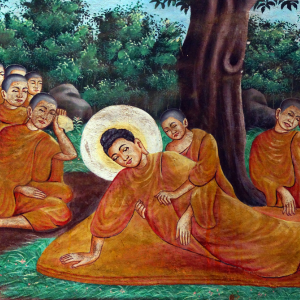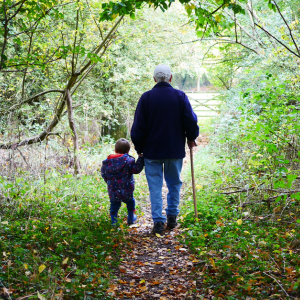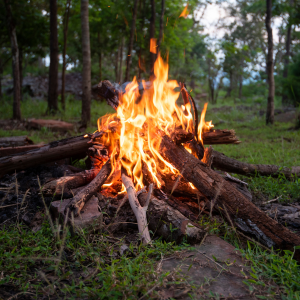Thursday
Community ArticlesTrauma & Meditation
By John Seex
We are All Traumatized
We think that when we meditate we will become calmer but as one student recently shared with me, after years of meditation she feels more confused and in some ways less calm: when we work on ourselves and meditate we feel more. And sometimes the first thing we feel is numbness, that we can’t feel, that we’re frozen. At this point we can feel as if something has gone wrong but this is the path, to feel into our frozenness and slowly melt: to learn how to feel again.
We can feel into how the mind is held in the body. How trauma, you could even say how karma, is held in the body. I have seen how trauma is embodied in individuals in relationships and in communities. In the Shambhala community we have collectively suffered a trauma: something we took for granted has fragmented; our confidence in our community has been shaken and for some people the person they put their trust in has betrayed them. We are all traumatized. Even the Buddha was traumatized. He lost his mother seven days after he was born and then when he grew up he was overwhelmed by the suffering he discovered and wanted to find a cure from the stormy waves of birth, old age, sickness and death.
The Meaning of Trauma
Trauma means wound, it’s from the Greek; I cut my finger with a drill recently and I can see the wound and feel it and my hand feels different. Trauma is an emotional wound: it’s about being overwhelmed by one’s internal reaction, an emotional/physiological response to an event. At the root of this experience is a fear that we could die, or not exist. So it is our animal response to the fear of not surviving. The other key element is that we experience it alone or we have to survive it alone. When researchers look at the impact of traumatic events on survivors, the negative impact is much less if the victim witnessed, accompanied, and/or they shared it with a group. The experience is more workable and can be integrated rather than just braced against (frozen).
There are different types of trauma, one is intergenerational trauma from our history with many wars, and all the things that our parents, grandparents, and great-grandparents went through. After giving this talk I met one person whose father was killed in Cambodia as part of Pol Pot’s genocide and another whose grandparents died in a concentration camp. Previous generations had to survive, but we are in a position to process what they felt but couldn’t process.
There’s also relational or developmental trauma that happens over time and is a relational pattern. This can be linked to inter-generational trauma, where relational/emotional patterns are passed on through ways of relating to each other. This is very helpful to understand because it makes sense of why we react so strongly to seemingly little events. When the people we expect to care for us let us down or don’t meet/encourage an aspect of ourselves or even treat us badly this can lead to a relational or developmental trauma, a sensitivity in us to being emotionally wounded in a similar way.
For example, if someone criticizes you, saying you don’t make sense, then you might think, ‘Oh yes, that’s right because I’m stupid; I can’t think straight because I’m stupid. Oh yes, everyone’s told me I’m stupid, I know I’m stupid.’ and then we fall down the rabbit hole and experience the trap of doubt, doubt in our fundamental basic goodness. There’s no way out, there’s no release because when we go into this trauma cycle it’s timeless so we experience it as if it’s happening now and we think we will be stuck in this feeling forever. So one of the ways we process trauma is to learn to discriminate between what is happening now and what happened back then.
The image I often use with clients is that our emotional reaction is like an iceberg, the top of the iceberg is a small thing that happens in your everyday life. For example my partner says to me, ‘You left the cupboard doors open again,’ and I feel, ‘Oh, she’s telling me off again. I’ve done it wrong, people don’t care for me, they just tell me what I am doing wrong.’ It’s like I feel I live in a punitive environment like a prison or boarding school and rather than be cared for, I am constantly criticized and put down. My story/emotional memory is triggered and the biggest part of the iceberg, underneath the water, is all the times that I have felt something similar where I have felt I didn’t do it right, I got it wrong, there’s something wrong with me. So when I experience the tip of the iceberg, I experience the whole iceberg, all the frozen energy from my lifetime’s experience that I haven’t processed and this creates the sense of overwhelm.
So how do we process this frozen energy? We need to be able to share it, have it witnessed by someone else who sees us. They understand, not just verbally, but we see it in their face that they understand our experience, and it makes sense to them. We also need to feel it by placing our mind on the physical sensation, the frozen energy in our body, and over a long time we can really melt this frozen energy, so that when things happen, we are less triggered. We still feel the emotional reaction, but it’s not charged by our previous experience like a volcanic eruption.
In terms of how this plays out with others, there is another helpful analogy. Imagine there is a pile of wood soaked in petrol and there’s a match and they come together and there’s a bonfire. So what is the cause of the bonfire? The encounter, the coming together, the petrol, the match? So imagine if there was a match, and an empty space, the match would just go out. So in this analogy, the fundamental cause of the bonfire is the pile of wood soaked in petrol. We are all piles of wood soaked in petrol walking around looking for a match and when the bonfire ignites we say, “Look what you did to me!” We do not fundamentally cause other’s emotional reactions but we may trigger them.
There’s a Jungian psychoanalyst, Donald Kalsched, who wrote a book called Trauma and the Soul, and he says “Trauma is an injury to the capacity to feel.” So what this means is, when we are traumatized, we split the mind and body. The mind goes off on it’s own trajectory and abandons the sensory body. This split then becomes habitual and we become desensitized, we lose the capacity to feel.
This splitting the mind and body, dissociation, is sometimes called the intellectual defense. We become very good at talking about life, about our emotions, but we are not actually present. And we do this because if we sense someone is not with us, particularly our caregivers when we are small, if they are not holding us in the cradle of loving kindness, we have to hold ourselves. And the most common way we hold ourselves is trying to make sense of things. We try to work out what is going on, rather than be present to what is arising in our bodily experience.
Healing is a gradual process of learning to come back into the body and feel our experience. Winnicott (a British psychotherapist) called it ‘indwelling’ to describe the healthy state of the mind dwelling in the body. I think that’s a beautiful, simple word: indwelling. Chögyam Trungpa Rinpoche says that when the mind and body are synchronized, there is no fear. This is an outrageous statement, but it’s true. When we are really there, present with our experience, we have no fear; we have no frightening thoughts about what’s happening. We might be upset/angry/scared but when we step into that experience we can tune into the self-existing energy of the present moment, windhorse.
This can become further solidified as an internal drama where different parts of ourselves are in conflict with each other. We are all in an internal drama; we’re not just one person, like a bus driver driving to our destination. We are the bus driver and all the passengers and we’re arguing whether we should stop to go to the toilet, where we want to go and whether the heating should be on. So, the idea is that if our caregivers were angry with us because we were upset, we learn very quickly ‘I mustn’t get upset, mummy and daddy won’t like me. And then we internalize this, and part of ourselves. We police ourselves to make sure we don’t get upset – this is called the Caretaker-Persecutor Complex, and this is why we begin to hate ourselves, because part of us is policing ourselves saying ‘don’t do that, you’ll get in trouble.’ So if we become vulnerable and upset, ‘oh no, don’t get upset!’ Something comes in our mind and says ‘don’t be so stupid, don’t do that again, you idiot, don’t cry.’ So while it’s trying to protect us, it also can become very demonic. If you say to someone, ‘don’t be so hard on yourself’ it can sound unthoughtful or patronizing or denying someone else’s experience. Loving kindness is not about stopping our self-hatred, but rather softening and understanding that self-hatred.
I want to explore how this might present itself in a meditation retreat situation. When we are feeling our trauma and are overwhelmed, we can either speed up, hyper-arousal or shut down, hypo-arousal. When you see someone like this, nothing’s happening. They’re a bit quiet, maybe they’re just a shy person, and we’re not sure, because there are no obvious signs. So the common question we often ask each other, ‘how do you feel?’ is not always helpful. Often people don’t know how they feel and what can be more helpful is to explore sensation, the ground of their experience: how is the feeling in your hands? How is the temperature? How is the feeling in your chest? What can you hear? What can you smell? Coming to basic phenomenological experience and sensory experience because this is the first layer. When we are in contact with our sensory experience, this then leads to being able to name our feeling and what this means: oh I feel sick in my stomach; I’m feeling anxious; so I don’t feel quite safe.
I think, what’s useful in working with others is a sense of psychological first aid or emotional first aid. What do we do when someone is upset, angry, punching the wall? What do we do? It depends on the context. It depends on your relationship with this person. It depends on many things. I just want to name some factors or elements to think about. There was one time we were on a retreat in a big tent, hundreds of people being very quiet, and someone started screaming. No-one moved except one person who knew this person. They walked up to her, touched her on the shoulder and they went outside. Everyone else carried on meditating, which felt quite strange, because you think when someone’s upset you have to do something, but actually there was a sense of container. It was very profound. So help was given, but people didn’t react. They stayed.
The Container Principle
This is the container principle – the tent is a container. We often have a door, we have a gong, we sometimes have a gatekeeper. So there’s a container here, and within the container we can feel more safe. So this is very important when you think about meditation interviews, or where the retreat is happening. Things like, where is nearest the door? Is the new person able to see the door, or are you blocking the door? Because this will really affect their sense of safety. Another example was when on a retreat the teacher leading the exercise asked us to lie down and I felt anxious. The teacher then said if you feel uncomfortable then you can take another posture and I immediately relaxed. So having a choice is really important.
Another example I experienced was when one of the participants on a month-long retreat felt overwhelmed sitting on a cushion all day long being with their thoughts and so we suggested they work in the garden for the afternoon, to be outside doing something physical. When you really understand the elements of what we’re doing in meditation you can appreciate that sitting on the cushion is one form. It’s a very important form and we find it very useful but it is one form and there are many forms. There is more than one way to crack a walnut as we say in English.
And lastly the container principle is also about mind. Another interesting psychotherapist, called Bion, talked about the container principle. He has an image that when the baby is born it’s full of experience and the mother’s (because it usually is the mother but it could also be the father or the step parent) job is to contain experience and to hand it back to the infant in bite-sized chunks. For example, the baby feels a surge of overwhelming experience and the mother or caregiver contains this and then feeds something back, ‘Oh, are you hungry? Is your diaper wet? Do you want to be picked up?’ So it’s breaking down an overwhelming experience into bite-sized chunks.
It’s not that you solve the trauma, but more so that you learn to be with your own mind and learn to relax with the edges, charge and upset that you can experience at times. This is part of being a container, providing the container function for others. As Karen Kissel-Wegela who was a main teacher of contemplative psychology at Naropa said we can offer “the hospitality of our mind.”
We can only be available to others to the extent that we can be there for ourselves and therefore it’s important that we have an awareness of our own limits, of our own capabilities. It’s not skillful to invite people to unpack their trauma with you when you’re not emotionally available, you don’t have time to do it, or you’re not skilled enough or confident enough to handle it.
Our response can be simple and straightforward. Many years ago I was on retreat and after a discussion group I was lying on the grass and I couldn’t move. I went catatonic. And I couldn’t move for three hours. Just rigid. And someone just came and held my head. Someone held my head for like two or three hours. And afterwards I said to her, how did you know what to do? And she said, I’m a mother. So she just responded to what was in front of her. It wasn’t complicated.
In my experience, the more we meditate the more sensitive we become to our internal feelings and to our anxiety. In some ways we’re getting deeper and deeper into the soup of being human and in many ways there is no way out. What changes is we are less identified with our experience, we learn it’s not personal and we begin to hold it in a bigger container.
***








